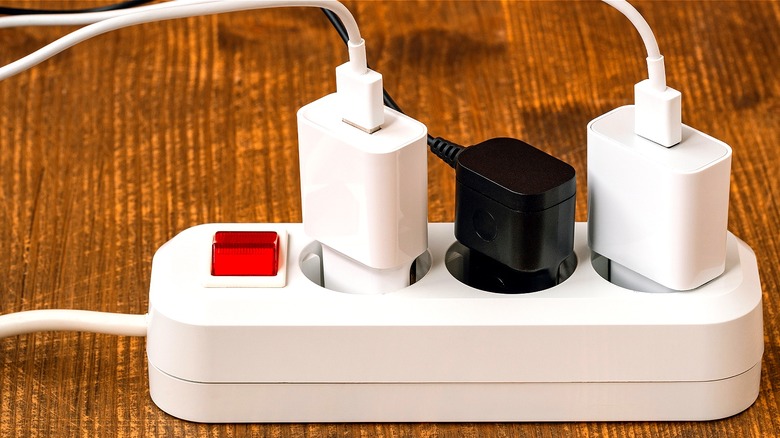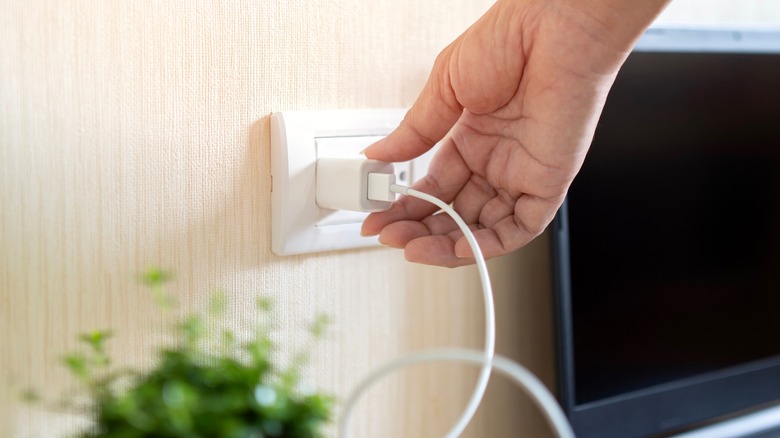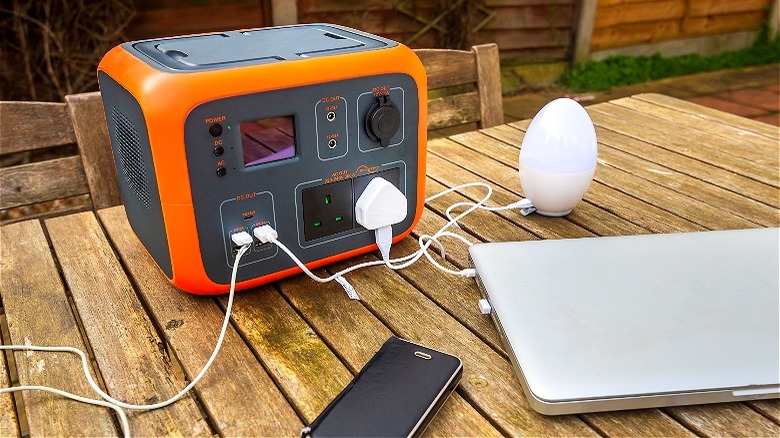Vampire Energy: Is Leaving Your Phone Charger Plugged In Costing You?
If you've never heard the term "vampire energy," you're not alone. According to a MarketWatch survey, nearly 70% of Americans aren't aware of the concept of vampire energy, aka standby power or phantom power, which is the electricity devices draw even when they're not being used because they're idle or in standby mode. For example, if your electronic device or appliance has a standby light illuminated and/or can be activated by remote control or voice command, it's silently using small amounts of pricey energy.
Common examples of energy suckers include smart appliances, TVs, printers, and cable boxes. To stop these devices from unnecessarily running up your utility bill, you may be able to change the factory settings to disable standby mode or eliminate always-on displays, like a clock. Additionally, you can plug multiple offending devices into a power strip which can be turned on and off with a single switch or, in the case of "smart" power strips, automatically when not in use.
However, what about those tiny AC adapters that we all use to charge our smartphones and other electronics like tablets and our laptops? Sometimes called "wall warts," these devices convert 110-volt electricity (in the U.S., anyway) to a voltage and amperage that's appropriate for USB cables or other proprietary charging cables, like Apple's old lightning cable. It turns out these wall chargers also use a small amount of energy, even when not in use. So what can you do about it?
A quality AC adapter can make a difference
According to actual testing done by ZDNet, an authentic Apple 5-watt iPhone charger uses ~1.5 kilowatt-hours over the course of a year when left plugged in, but not actually charging anything. In some of the most expensive states to live in, such as Hawaii, that equals about 50 cents a year for leaving the charger plugged in continuously. In cheaper states, that amount gets cut in half. In any case, it's hardly worth taking special measures over.
With this said, aftermarket phone chargers can be noticeably less efficient than those provided by phone manufacturers. In fact, cheap chargers can draw 10 to 20 times as much energy when idle as their genuine counterparts. Still, that's less than $10 in wasted electricity in a year in a worst-case scenario. So unless you have a whole household full of these less-efficient chargers, it may not be worth adding a power strip or plugging and unplugging them.
By the way, electrical outlets that combine 110-volt receptacles with the ability to plug in one or more USB cables operate on the same principle as phone "wall wart" chargers; it's just consolidated in a single unit. As such, those outlets with built-in USB charging ports are drawing power all the time, even when nothing is plugged in. Like the OEM-versus-aftermarket-charger scenario above, it's worth buying high-quality receptacles from reputable manufacturers to begin with, which are likely more efficient.
Laptop chargers suck more power, right?
Next, you might be wondering about chargers for laptop computers. Though they've been growing smaller in recent years, there's still a certain brick-like characteristic to many laptop chargers. That's not to mention they get pretty warm while actually charging. However, in idle mode, they're not the vampire energy suckers that you might assume. According to a test performed by How-To Geek, it's safe to assume that modern laptop chargers won't draw more than 1-watt in standby mode. That's compared to OEM cellphone chargers which draw 0.1 watt or less when idle.
So yes, leaving laptop chargers plugged in all the time is more wasteful than doing the same with cellphone chargers. Presumably, chargers for devices like tablets fall somewhere in between phones and laptops. That said, even the more power-hungry laptop chargers are fairly benign in the grand scheme. As a comparison, a typical LED light bulb consumes ~10 watts of energy, according to EnergySage, so you'd need to have 10 inactive laptop chargers — or literally dozens of cellphone chargers — plugged in to equal leaving one LED light bulb on continuously.
In summary, while the most miserly among consumers might consider regularly unplugging or adding a switchable power strip for their various electronics chargers, efforts to save money on an electric bill are probably better directed elsewhere, especially when you consider that the average home is said to have up to 40 devices drawing vampire energy at any given time. Or that nearly a decade ago, the NRDC had already put the average of connected devices in homes at 65 in its paper "Home Idle Load: Devices Wasting Huge Amounts of Electricity When Not in Active Use."


